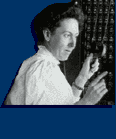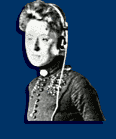 |
 |

 |
1 | 2
|
|
To be an operator, a woman had to be unmarried, between the ages of seventeen and twenty-six. She had to look prim and proper, and have arms long enough to reach the top of the tall telephone switchboard. Much like many other American businesses at the turn of the century, telephone companies unfairly discriminated against people from certain ethnic groups and races. African American and Jewish women were not allowed to become operators.
|

|
|

|
Because women were generally discriminated against, operators' wages were low. And operators seldom got the respect they deserved. The typical operator earned about $7 per week -- a small salary even in 1900. She worked ten or eleven hours a day, six days a week. If necessary, she also worked nights and holidays. An operator who got married was forced to leave her job. To many early telephone users -- most of whom were wealthy -- the telephone operator was just another household servant.
|
|
|
Still, the operator was the heart of the telephone system. She watched over a switchboard containing up to 200 phone lines, listening in with her clunky metal headset. Her main job was to plug callers' phone lines into the phone lines of the people they wanted to speak to. But she often acted as the town's information source, too. Operators were also expected to inform customers of election results, streetcar breakdowns, storms, train arrivals, and much more.
|

|
|

|
In 1900, the life of the rural operator was very different from her peers in the city. The telephone was a big hit with the farm families who could afford one. But there were rarely enough calls to tie a rural operator to her switchboard. To help pass the time, some women attached long cords to their headsets. That way, they could walk around their homes doing chores while they waited for the phone to ring. Rural operators enjoyed a lot of independence.
|
|

|
|

